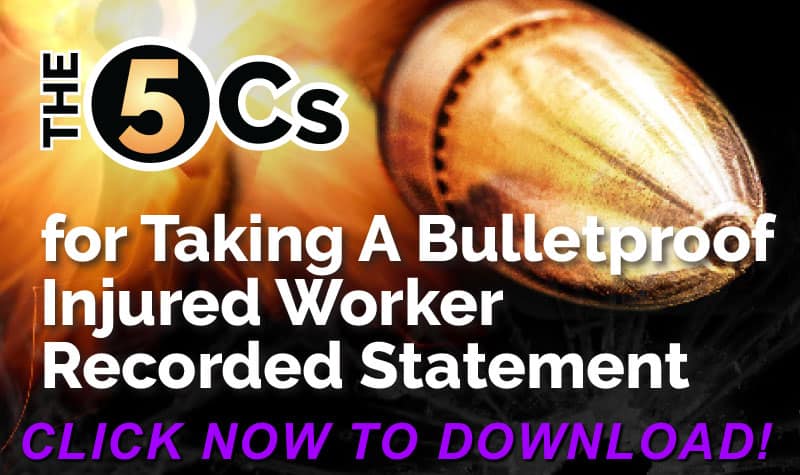Surveillance is expensive. The cost of a private investigator (PI) to establish the claimant’s workers compensation injuries are not real or exaggerated, varies from $75 to $175 per hour, depending on the location and the legal requirements within the state to become a private investigator. The cost of surveillance can quickly escalate as the private investigator sits and waits all day for the claimant to come out of his house or to leave and travel away from the claimant’s residence. Too many $1,000 to $2,000 invoices received by adjusters, only to learn that the claimant came out on his porch several times to smoke cigarettes, or walked out to the mailbox, has made many adjusters skittish about using surveillance.
To stop a fraudulent claim with surveillance requires the surveillance to be used correctly and in the right situation. Here are the most appropriate times to use surveillance.
- When the employee claims he is so severely injured that he is unable to do anything.
- When there is a strong reason to believe the limitations of the injury are not as stated
- When it is learned the employee is working elsewhere
- When the claim has the potential to become catastrophic
- When there is a need to stop a claim that all the co-workers know is fraudulent
Click Link to Access Free PDF Download
“The 5Cs to Taking a Bulletproof Injured Worker Recorded Statement”
The Exaggerator
With the exaggerator, the employee had a verifiable accident, but the alleged injuries are way out of proportion to the objective medical evidence. For instance, the employee fell and bruised her knee. The next thing the employee is treating for injuries to her neck, upper back, lower back, both knees, headaches, and fibromyalgia. The employee tells the medical provider she hurts so bad that she can hardly walk and any effort to lift anything creates intense pain.
Surveillance video showing the employee walking through the mall carrying several purchases will discredit the employee’s subjective complaints, but it usually will not lead to her quick recovery. The exaggerator once confronted with the lie about her injuries will quickly concoct another lie, like she had accidentally taken an overdose of her pain medicine, so she went to the mall to get the things she needed before the pain came back. One thing smart adjusters know about surveillance is usually more than one day of video to refute the excuses of the employee’s caught on film is needed.
Phony Limitations
Medical providers often determine the work restrictions they place on an employee by the information they receive from the employee. This is especially true with back injury claims where the employee is unable to bend or twist and is given a low weight lifting restriction. If there is not a modified duty program, then all the employee needs is a no lifting restriction to be off work. While it may be rare the employee actually has to lift 25 pounds, the employee has told the doctor that he has to frequently lift 25 to 50 pounds. The doctor assigns a 10-pound lifting restriction to protect the employee from further injury.
Surveillance can be effective if the employer or the adjuster knows the claimant’s off work routine and can plan the surveillance for a time when it is believed the employee will be active. Unfortunately, if the adjuster does not know when the employee may be active, surveillance is often wasted money as the PI has to be at the right place at the right time to catch the claimant lifting anything.
Got Another Job*
Most employees who fake an injury or exaggerate a real injury do so because they do not want to work. However, occasionally there will be an enterprising employee who thinks he can work at another job while collecting workers compensation from the insurer. The new job maybe seasonal work or could be another job the employee wants to try out before turning in his resignation.
Often the employer will receive a tip from another employee or even anonymously that the “injured” employee is working for a competitor or in an unrelated business. This is an excellent time to use surveillance as the workers’ compensation claim can be brought to a quick conclusion with video of the employee working at another job.
*You may know your employee has another job prior to their claim, or your employee may tell you the truth about the other role before you found out through investigation. If this is the case, you may want to conduct surveillance if you think they are performing more significant work than what they can provide for you.
Catastrophic Injuries
When the employee is seriously injured with the potential to be designated as a total permanent disabled person, surveillance should be used to verify the limitations of the employee. Often the surveillance will prove the employee is unable to walk without a cane, or cannot bend to get into his automobile, or must have assistance to climb steps. Surveillance in this situation can justify bringing the claim to a quicker settlement based on the verified physical limitations of the employee.
Occasionally the surveillance will show the claimant has the doctors fooled and the extent of the injury is not nearly as severed as the employee has portrayed. While the odds are against the PI being successful, when the PI does prove the employee is not seriously injured, or the injuries do not limit the claimant as the claim cost savings can be substantial.
The Co-workers Know it is Fraudulent
When the employee has told the entire department that he is going to “take a vacation on workers comp”, the employer knows the employee has to be caught. If the employee does not even care it is known that the claim is highly questionable, the failure to stop it will set the company up for many more bogus workers comp claims.
When the employer presents sufficient evidence to the adjuster that the claim is fraudulent, the adjuster will often assign surveillance. If the adjuster does not, the employer should. If the employee is allowed to present a phony work comp claim and gets paid time off, the employer can expect other employees to file copy-cat claims when they want a paid leave of absence.
Surveillance needs to be used to prove the claim is fraudulent. Ample documentation needs to be compiled through surveillance to prosecute the employee for fraud. When the employer prosecutes fraud, the number of fraudulent claims quickly drops to near zero.
If appropriately used, surveillance can reduce the cost of fraudulent claims. Anytime you think a claim is fraudulent or you believe surveillance has potential to prove a claim to be bogus, contact your workers’ compensation adjuster, and discuss why you think surveillance is needed. You will often be right.

Author Michael Stack, CEO Amaxx LLC. He is an expert in workers’ compensation cost containment systems and helps employers reduce their workers’ comp costs by 20% to 50%. He works as a consultant to large and mid-market clients, is a co-author of Your Ultimate Guide To Mastering Workers Comp Costs, a comprehensive step-by-step manual of cost containment strategies based on hands-on field experience, and is founder & lead trainer of Amaxx Workers’ Comp Training Center.
Contact: mstack@reduceyourworkerscomp.com.
Workers’ Comp Roundup Blog: https://blog.reduceyourworkerscomp.com/
©2018 Amaxx LLC. All rights reserved under International Copyright Law.
Do not use this information without independent verification. All state laws vary. You should consult with your insurance broker, attorney, or qualified professional.













